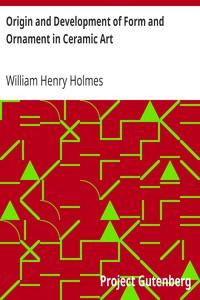|
|
Read this ebook for free! No credit card needed, absolutely nothing to pay.Words: 13132 in 4 pages
This is an ebook sharing website. You can read the uploaded ebooks for free here. No credit cards needed, nothing to pay. If you want to own a digital copy of the ebook, or want to read offline with your favorite ebook-reader, then you can choose to buy and download the ebook.

: Origin and Development of Form and Ornament in Ceramic Art. Fourth Annual Report of the Bureau of Ethnology to the Secretary of the Smithsonian Institution 1882-1883 Government Printing Office Washington 1886 pages 437-466. by Holmes William Henry - Potte@FreeBooksTue 06 Jun, 2023 Page. FIG. 464.--Form derived from a gourd 446 465.--Form derived from a conch, shell 447 466.--Form derived from a stone pot 448 467.--Form derived from a wooden tray 448 468.--Form derived from a horn spoon 448 469.--Form derived from a bark vessel 446 470.--Form derived from basketry 449 471.--Form derived from basketry 449 472.--Form derived from a wooden vessel 449 473.--Coincident forms 451 474.--Form produced by accident 451 475.--Scroll derived from the spire of a conch shell 454 476.--Theoretical development of current scroll 455 477.--Ornament derived through modification of handles 455 478.--Scroll derived from coil of clay 456 479.--Ornamental use of fillets of clay 456 480.--Variation through, the influence of form 459 481.--Theoretical development of the current scroll 460 482.--Forms of the same motive expressed in different arts 461 483.--Forms of the same motive expressed in different arts 461 484.--Forms of the same motive expressed in different arts 461 485.--Geometric form of textile ornament 462 486.--Loss of geometric accuracy in painting 462 487.--Design painted upon pottery 463 488.--Theoretical development of fret work 464 489.--Theoretical development of scroll work 465 ORIGIN AND DEVELOPMENT OF FORM AND ORNAMENT IN CERAMIC ART. BY WILLIAM H. HOLMES. INTRODUCTORY. For the investigation of art in its early stages and in its widest sense--there is probably no fairer field than that afforded by aboriginal America, ancient and modern. At the period of discovery, art at a number of places on the American continent seems to have been developing surely and steadily, through the force of the innate genius of the race, and the more advanced nations were already approaching the threshold of civilization; at the same time their methods were characterized by great simplicity, and their art products are, as a consequence, exceptionally homogeneous. The advent of European civilization checked the current of growth, and new and conflicting elements were introduced necessarily disastrous to the native development. The material presented in the following notes is derived chiefly from the native ceramic art of the United States, but the principles involved are applicable to all times and to all art, as they are based upon the laws of nature. No form or class of forms can be said to characterize a particular age or stage of culture. In a general way, of course, the vessels of primitive peoples will be simple in form, while those of more advanced races will be more varied and highly specialized. The shapes first assumed by vessels in clay depend upon the shape of the vessels employed at the time of the introduction of the art, and these depend, to a great extent, upon the kind and grade of culture of the people acquiring the art and upon the resources of the country in which they live. To illustrate: If, for instance, some of the highly advanced Alaskan tribes which do not make pottery should migrate to another habitat, less suitable to the practice of their old arts and well adapted to art in clay, and should there acquire the art of pottery, they would doubtless, to a great extent, copy their highly developed utensils of wood, bone, ivory, and basketry, and thus reach a high grade of ceramic achievement in the first century of the practice of the art; but, on the other hand, if certain tribes, very low in intelligence and having no vessel-making arts, should undergo a corresponding change of habitat and acquire the art of pottery, they might not reach in a thousand years, if left to themselves, a grade in the art equal to that of the hypothetical Alaskan potters in the first decade. It is, therefore, not the age of the art itself that determines its forms, but the grade and kind of art with which it originates and coexists. ORIGIN OF FORM Free books android app tbrJar TBR JAR Read Free books online gutenberg More posts by @FreeBooks
: Autographs for Freedom Volume 2 (of 2) (1854) by Griffiths Julia Editor - Antislavery movements United States; Slavery United States@FreeBooksTue 06 Jun, 2023

: Potash and Perlmutter Settle Things by Glass Montague - Jews New York (State) New York Fiction; Clothing trade New York (State) New York Fiction; World War 1914-1918 Peace Fiction@FreeBooksTue 06 Jun, 2023
|
Terms of Use Stock Market News! © gutenberg.org.in2025 All Rights reserved.






